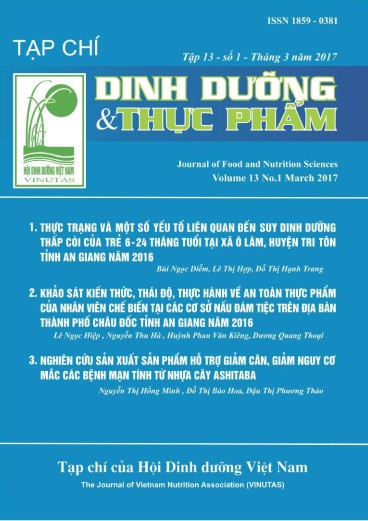STUDY ON TYPE Of SUBSTRATES TO GLUCOSINOLATE AND ANTIOXIDANT ACTIVITY Of VEGETABLE SPROUTS
Main Article Content
Abstract
In this study, we investigated the possibility of glucosinolate biosynthesis of active substances (GLS) and resistance to oxidation (SC50) in red beet sprouts on different types of substrates, in order to select the type of substrate for biosynthesis of active and capable
GLS highest antioxidant. Substrate No.1 made by biochar and straw humus suitable for
the biosynthesis of concentration GLS and high antioxidant activity was selected. When
planting red beet sprouts on the substrate No.1, concentration GLS was 23.45 mg sinigrin/100 g fresh weight, SC50 was 395.07 µg/ml and crop yield was 1021.51 g. When
adding the amino acid L-Tryptophan 50 mg, additional time on day 3 for GLS content and
high antioxidant ability were 28.63 mg sinigrin /100 g fresh weight and 290.8 µg/ml, respectively.
Keywords
Glucosinolates, antioxidant ability, sprouts, substrates
Article Details
References
2. Brooks JD, Paton VG, Vidanes G (2001). Potent induction of phase 2 enzymes in human prostate cells by sulforaphane. Cancer Epidemiol Biomarkers Prev, V.10(9), pp. 949 - 954.
3. Charlotte N. Armah et al (2015). Diet rich in high glucoraphanin broccoli reduces plasma LDL cholesterol: Evidence from randomised controlled trials. Mol. Nutr. Food Res, 59, pp. 918 - 926.
4. Galan M.V., Kishan A.A., Silverman A.L. (2007). Oral broccoli sprouts for the treatment of Helicobacter pylori infection: a preliminary report. Dig Dis Sci., 49 (7 -8); pp 1088 - 1090.
5. Rangkadilok. N et al. (2002). Developmental changes of sinigrin and glucoraphanin in three Brassica species (Brassica nigra Brassica juncea and Brassica oleracea var italica). Sci. Hortic, 96, pp. 11 - 26.
6. Rijken P.J et al (1999). Effect of vegetable and carotenoid consumption on aberrant crypt multiplicity, a surrogate end-point marker for colorectal cancer in azoxymethane-induced rats. Carcinogenesis, 20(12), pp. 2267 - 2272.
7. Ruud Verkerk et al, 2009. Glucosinolates in Brassica vegetable: The influence of the food supply chain on intake, bioavailability and human health. Mol.Nutr.Food Res, 53, pp. 219 - 265.
8. Shela G. et al (2003). Bioactive ompounds and antioxidant potential in fresh and dried Jaffa sweeties, a new kind of citrus fruit. J. Nutri. Biochem., 14 pp 154 - 159


